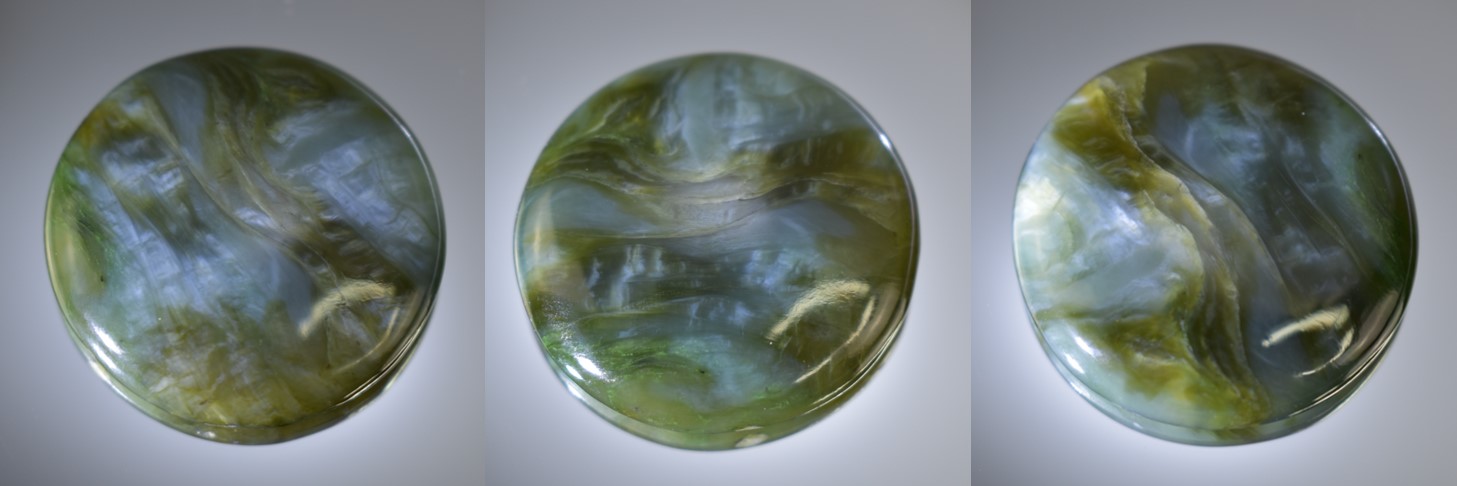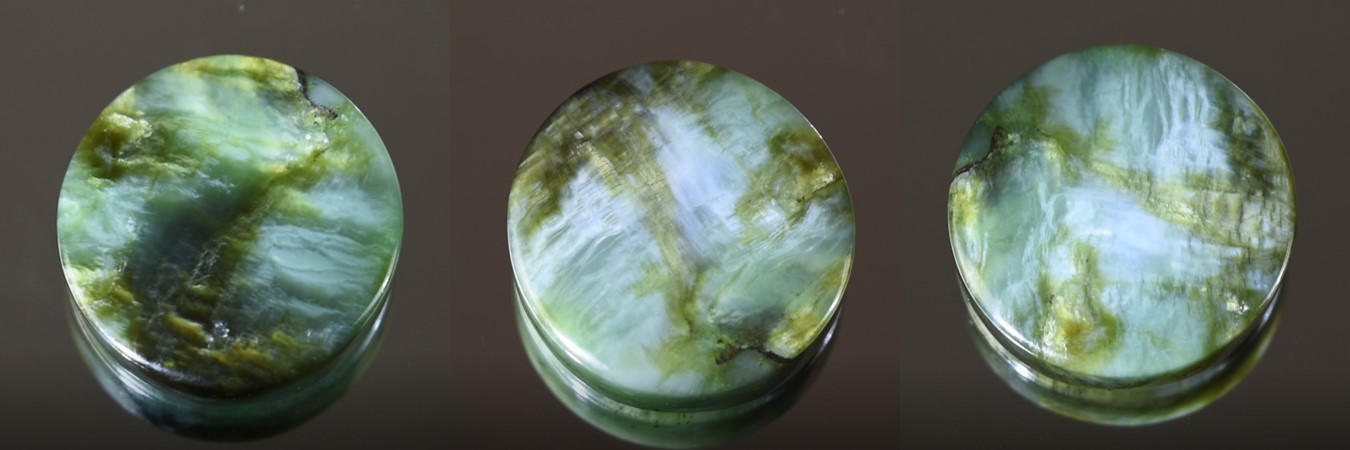DJ Project
The DJ project was the Company’s first project where extensive Jade occurrences have been outlined at surface, containing 4 major different classes of nephrite Jade including ornamental material, carving/jewellery type, near gem to gem quality material, and a unique Color Shift Jade (Video companions: Jades of the DJ project and Change in The Jade World).
Figure 1: Major Nephrite Jade types of the DJ Project, Washington State, USA. A: Green Ornamental Jade. B: White-Green Carving/Jewellery Jades. C: Fine grained green to blue green Gem Jades. D: A new and unique nephrite Jade showing a complex color shift optical phenomenon.
The Company announced the acquisition of the DJ Jade project, in Washington State, USA, on August 28, 2017, through a combination of an Option Agreement and staking. The full Option to earn 100% of the mineral rights, subject to a 2% NSR was exercised in full in November of 2018 by the Company.
The property consists of Lode Claims covering an area of slightly more than 140 hectares, which originally was known to host 3 small, isolated historic nephrite jade occurrences.
From August to October of 2017, the Company conducted reconnaissance prospecting, detailed geological mapping, preliminary ground geophysics, and trenching and mechanized sampling. Subsequently, samples representing the various Jade types present on site were examined, classified, then cut and polished in a suite of samples representative of the various materials found.
Surface mapping outlined two significant Jade bearing structures, Lode 1 and Lode 2.
Figure 2: Field exploration and sampling activities at the DJ Project. A: portable diamond saw cutting of a Jade vein in trenching. B: Low footprint hydraulic diamond coring drill rig, testing to over 30 meters deep for Jade. C: Drill core of Jade intersected at 30 meters depth from trench shown in (A). Core is 6.3 cm in width. D: Jack hammer removal of host serpentinite unit to access Jade veins.
Lode 1 was outlined by tracing intermittent outcrops and subcrops over a strike length in excess of 140 meters, remaining open in all directions. Widths of the in-situ Jade occurrences, when exposed, vary between 0.5 to 1.5+ meters, within a Jade hosting structure that appears to be potentially locally up to 10 meters in width.
The Lode 1 target was drill tested in October-November 2018 with 6 drill holes along three sections along 80 meters of its 170+ meter strike length. Holes were drilled to vertical depths ranging up to 30 meters. Significant Nephrite Jade intervals were field identified in core in L1 DD1 (1.95 meters), L1 DD2 (1.68 meters), L1 DD3 (0.65 meters), L1 DD4 (0.92 meters) and L1 DD6 (0.50 meters). While the productive Jade zone was also intercepted in drill hole L1DD5, pervasive overprinting quartz veining and hydrothermal alteration obliterated all Jade textures in the zone. All Jade identified from Lode 1 drill core was ornamental; typically mottled, dark to light green; potentially suitable for commercial carvings and ornamental uses. The target remains open along strike in both directions, as well as at depth.
Lode 2 had been hand trenched and fully exposed at surface in 2 sections, respectively 11.2 meters and 8 meters in length, with outcrop widths varying between 0.2 to 0.5 meters (southern section) to 1meter+ (north section). These two sections are part of a jade bearing structure identified by mapping and intermittent outcrop with in excess of 50 meters of strike length to date.
The Lode 2 target was drilled in October/November 2018 with 7 holes along 33 meters of its previously identified 50+ meters of strike length, to a maximum vertical depth of 30 meters below the main surface outcropping/trench.
All drill holes into Lode 2 intersected continuations of the Jade units identified at surface: either continuous intervals of massive to locally foliated nephrite, or as zones of thin veins 0.5 to 8 cm in thickness or stockworks of typically finer grained, highly translucent Jade in a serpentinite matrix. Significant Nephrite Jade intervals were field identified in core in drill holes L2 DD1 (massive 0.85 meters and additional stockwork 0.40 meters), L2 DD2 (5.05 meters of dominantly massive to locally foliated nephrite Jade with minor bands of diopside), L2 DD3 (massive to foliated 0.9 meters, additional stockwork zone, 1.5 meters), L2 DD4 (1 meter, massive to foliated), L2 DD5 (0.60 meters massive to foliated and 0.20 meters stockwork zone), L2 DD6 (2.6 meters, massive to foliated) and L2 DD7 (2 distinct stockwork zones of 3.45 meters and 1.2 meters). Colors of the various materials varied from dark to light green as well as blue-green to light blue. Based on textures, colors and translucency observed in the core, Jade types included ornamental, carving/jewelry, near gem/gem as well as Jade material typical of previous samples exhibiting a unique color shift phenomenon. All identifications are subject to final determination after polishing of the materials from key sections.
All targets remains open in all directions along strike and at depth.
DJ Color Shift Jades-A New Phenomenal Gemstone Type
Ongoing investigations, research and processing work have resulted in a nephrite Jade type unique in its ability to shift color depending on viewing angles. This is due both to complex directional changes in the fibrous minerals that compose the Jade, as well as variations in chemical compositions. Stone that exhibit unusual optical effects or phenomena such as this color shift are referred to in gemmology as “Phenomenal stones”.
Figure 3: Composite picture of cabochon cut stone (JLCS5), showing the color change as the stone is rotated relative to a fixed light source. Stone is 36.5 mm by 35 mm in diameter and weighs 17.6 grams/87.9 carats.
Figure 4: Composite picture of cut stone (JLCS4). Stone is 36.6 mm by 36.1 mm in diameter and weighs 33 grams/165 carats.
Figure 5: Composite picture of cut ring stone (JLCS8). Stone is a round 8.8 mm and weighs 0.54 grams/2.7 carats with a high vitreous luster and sharp transition from white to green, depending on viewing direction. While chatoyant or “cat’s eye” Jades (both nephrite and jadeite) have been documented before from various locations, chatoyancy refers to a band of light caused by reflection along inclusions or parallel underlying fibers within the stone. It is not associated with an actual change of perceived color for the body of the stone itself.
Figure 6: Composite picture of cut stone (JLCS10). Stone is a 17.1 mm by 7.4 mm marquise cut cabochon and weighs 0.7 grams/3.6 carats. High vitreous luster, high translucency in bands, and sharp color changes from dark to light greens and light blues.
While historically, cat’s eye jades have been widely included in this particular gemstone category, to our knowledge, there is no description in the Jade literature to Jades which exhibit strong and distinct color changes. This change, on a stone by stone basis, can vary from green, to white, to a range of blues. Having now recognized this stone type, and having developed the appropriate processing protocols required to properly highlight this color change property, the Company will investigate both market acceptance of this new stone, and investigate extraction possibilities on an ongoing basis in the field as conditions allow.
DJ Project-Rhodonite, A Jade Associated Gemstone
Rhodonite, a semi-precious gemstone historically used in carvings, ornamental objects, beads and cabochons has been found closely associated with Jade occurrences at the DJ project. Colors are dominated by pinks to reddish pinks, with occasional presence of yellows, blues, purple, grey and white. Attractive manganese dendrites and veins are common within the material, which in its rough form is always found covered with a black manganese coating.
Over 5,000 pounds of this material (2,200+ Kg) has been harvested to date in pieces varying between 2-3 pounds (1+ Kg) to over 300 pounds (130+ Kg). Further extraction can be accommodated based on future demand.
Figure 7: DJ Project rhodonite. A: individual blocks on site. B: Large outcrop face, testing with angle grinder and polishing pads to confirm color below black manganese coating. C: Rough and cut suite of beads, and cabochons from DJ. D: Pendant of round and barrel beeds of cut and polished rhodonite from DJ.







